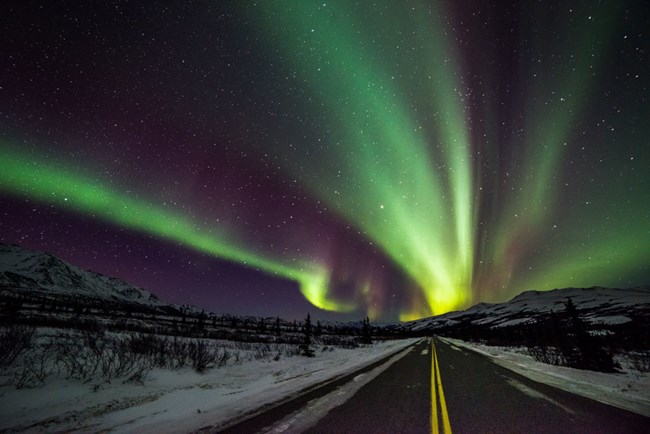Moderate Your Expectations When Viewing the Aurora
NPS Photo / Mary Lewandowski When photographers use cameras to take photos of the aurora and the night sky, they use long exposures. To take each photograph, the camera lens is left open for several seconds at a time. This allows the camera’s sensor more time to collect photons, or particles of light. Because the sky is dark and the aurora is relatively faint, collecting those photons for many seconds allows the photograph to appear brighter than the same scene will to your eye. You can improve your own nighttime eyesight by allowing your eyes at least 30 minutes outside to adjust to the dark and avoiding bright light sources, such as flashlights or cell phones. The aurora (as well as the stars, the Milky Way, and anything else you might hope to see) will start to appear brighter to your dark-adapted eyes. 
NPS Photo / Kent Miller Finally, be aware that time lapses and videos can exaggerate the movement of the aurora. On nights of very high activity, it’s possible to see the aurora shimmering and flickering rapidly. More commonly, it appears as a more stationary band of light that could take several minutes to slowly move in a wave across the sky. Light PollutionDenali is a great location for viewing the aurora because we are located at a far northern latitude and because there is very limited light pollution. Light pollution is found in towns, cities, and other developed areas where excessive artificial light brightens the natural environment. Dark night skies are valued by people who enjoy stargazing and aurora-viewing as well as by astronomers studying our universe through telescopes. But because of widespread light pollution, approximately 80% of Americans live in areas so light-polluted that they cannot see the Milky Way from their homes. The ability to identify constellations, to pass down stories about the night sky, and to develop an appreciation for observing planets, galaxies, and other wonders of the night sky are all at risk when people do not grow up with these experiences. Light pollution is a quickly-reversible form of pollution, so you can make a difference and help keep night skies dark for people and animals alike. Limited and thoughtful outdoor lighting is both environmentally friendly and energy efficient, as light is not wasted shining into the sky or into other areas where it is not needed. Choose night-sky-friendly lighting for your home and encourage your neighbors to do the same. Why Dark Skies MatterAlthough the night sky is appreciated by many, it is physically intangible and has taken longer to be recognized as a natural resource that requires protection. Today, the National Park Service studies the night sky and has scientists who work to protect it. Dark skies provide people with an opportunity to connect with our past and with our culture as we identify constellations and pass stories down through generations. They can humble us as we contemplate the size of our solar system, our galaxy, and the universe. They are also a critical component of natural ecosystems and are relied upon by wildlife to survive in the naturally dark environments they are adapted to. If you enjoy stargazing, you might already be familiar with some of the most well-known Greek constellations such as Ursa Major, Ursa Minor, Orion, and Cassiopeia. But Alaska Native people have paid attention to the stars for thousands of years and have their own constellations and associated star stories. Prepare for a visit to Denali by reading about traditional Athabascan star knowledge and challenge yourself to learn a new constellation, like the Ahtna constellation of Nek’eltaeni or the Gwich’in constellation of Yahdii. Learn More About the Aurora |
Last updated: January 3, 2025
